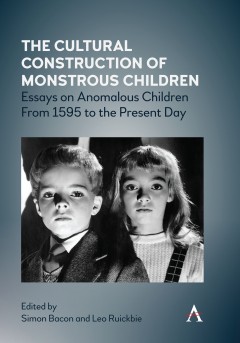The Cultural Construction of Monstrous Children
Essays on Anomalous Children From 1595 to the Present Day
Edited by Simon Bacon & Leo Ruickbie
Other Formats Available:
- About This Book
- Reviews
- Author Information
- Series
- Table of Contents
- Links
- Podcasts
About This Book
The Cultural Construction of Monstrous Children raises important questions at the heart of society and culture, and through an interdisciplinary, trans-cultural analysis, presents important findings on socio-cultural representations and embodiments of the child and childhood. At the start of the 21st century, new anxieties constellate around the child and childhood, while older concerns have re-emerged, mutated, and grown stronger. But as historical analysis shows, they have been ever-present concerns. This innovative and interdisciplinary collection of essays considers examples of monstrous children since the 16th century to the present, spanning real-life and popular culture. to exhibit the manifestation of the Western cultural anxiety around the problematic, anomalous child as naughty, dangerous, or just plain evil.
The linkage between children and horror, or horror-full children, would seem an almost natural connection to make given its popularity in contemporary horror films and novels. However, the intersection between the two categories has a long history going back beyond the more obvious Gothic reimaginings of the 19th century with its under-age ghostly terrors revealing that the idea of the ‘little horror’ is seemingly an inherent demarcation within society between adults and those that are viewed as ‘not adults’.
However, as seen in this timely and innovative collection, the anomalous child can also be seen in a positive light, and that resistance to easy categorization can be embraced by wider society as a force for change as can be seen in the recent example of a problematic child/adolescence, Greta Thunberg, a singularly focused individual, who is 16 years-old at the time of writing, has consistently refused to act as desired by the adult society around her in pursuit of gaining recognition of the urgent need for action in regard to environmental change. The book takes an inter- and multidisciplinary approach, drawing upon fields as diverse as sociology, psychology, film, and literature, to study the role of the child and childhood within contemporary Western culture and to see the ways in which each discipline intersects and influences the other, as well as viewing all this through a historical lens.
Reviews
Bacon and Ruickbie have assembled a diverse and fascinating bestiary of essays engaging the fear of and for children. With insight and nuance the contributors investigate teenage werewolves (real ones?), child zombies, ancient adolescent vampires, phantasmal progenies, evil offspring, and terrifying tykes, among other anomalous children from the Renaissance through the Slenderman era. Each essays offers an insight into the terrors of youth, but the whole is greater than the sum of the parts, revealing a tapestry of anxiety and dread regarding childhood and adolescence that transcends cultures and historic periods. Reader beware – you will never want to babysit again after this book. — Kevin J. Wetmore, Jr., Ph.D., Professor, Loyola Marymount University, Bram Stoker Award-nominated editor and author of Post-9/11 Horror in American Cinema
Author Information
Simon Bacon is an independent scholar based in Poznan, Poland. He has written extensively on vampires, monsters and the construction of difference in contemporary culture.
Leo Ruickbie is a writer, editor and social scientist specialising in controversial areas of human belief and experience. He is the author of several books on witchcraft, magic and the supernatural.
Series
Anthem Studies in Gothic Literature
Table of Contents
List of Illustrations; Acknowledgements; Introduction, Simon Bacon and Leo Ruickbie; Part I Historical Case Studies; Chapter One The Possession of John Starkie, Joyce Froome; Chapter Two The Naughty Little Children: The Paranormal and Teenagers, Renaud Evrard; Chapter Three I Was a Real Teenage Werewolf: The Seventeenth-Century Witchcraft Trial of Jean Grenier, Leo Ruickbie; Chapter Four Deviance on Display: The Feral and the Monstrous Child, Gerd H. Hövelmann; Part II Factual Anxiety in Fictional Representations: The Undead Child; Chapter Five Imprints: Forming and Tracing the Malevolent Ghost-Child, Jen Baker; Chapter Six Undead Role Models: Why the Zombie Child Is Irresistible, Anthony Adams; Chapter Seven Children for Ever! Monsters of Eternal Youth and the Reification of Childhood, Simon Bacon; Part III Factual Anxiety in Fictional Representations: The Monstrous Child; Chapter Eight ‘Not a child. Not old. Not a boy. Not a girl’: Representing Childhood in Let the Right One In, Allison Moore; Chapter Nine Perverted Postmodern Pinocchios: Cannibalistic Vegetal- Children as Ecoterrorist Agents of the Maternal Imagination, Anna Kérchy; Chapter Ten From the Monster to the Evil Sinthomosexual Child: Category Mixing, Temporality and Projection in Horror Movies, Marc Démont; Part IV Cultural Categorization in the Past, Present and Possible Future; Chapter Eleven Evil Twins: Changing Perceptions of Twin Children and Witchcraft among Yoruba-Speaking People, Nicholaj de Mattos Frisvold; Chapter Twelve Doli Incapax: Examining the Social, Psychological, Biological and Legal Implications of Age- Related Assumptions of Criminal Responsibility, Jacquelyn Bent and Theresa Porter; Chapter Thirteen Black- Eyed Kids and the Child Archetype, Brigid Burke; Chapter Fourteen Indigo Children: Unexpected Consequences of a Process of Pathologization, Gerhard Mayer and Anita Brutler; Notes on Contributors; Index.
Links
Stay Updated
Information
Latest Tweets



